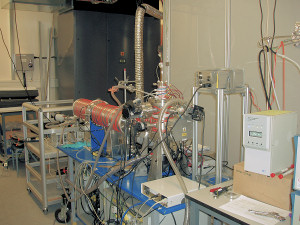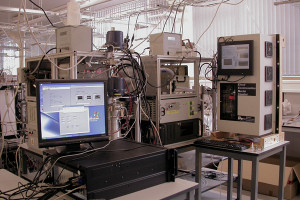ACES Project - Chamber studies of biogenic VOC emissions and SOA formation
Introduction
Smog chamber studies have been carried out since the 1960's to simulate the degradation of compounds and formation of organic aerosol in controlled atmospheres. Experiments have been generally carried out at concentrations and humidities which are not represenatative of the real atmosphere. Additionally most experiments have been carried out without the presence of background aerosol, forcing condensible material to form particles by homogeneous nucleation. While historically there were good reasons for carrying out experiments under these conditions, it has meant that it has been very diffcult to apply the results of chamber studies to the real atmosphere. Factors such as precursor concentration, humidity, and concentrations of NOx and ozone are all important in determining oxidation pathways. The presence of background aerosol will radically alter the final distribution of material in the aerosol phase by providing a pre-exisitng surface onto which condensation from the gas phase may occur. The chamber experiments carried out as part of the ACES project were carefully designed to be representative of real atmospheric conditions.
In a tropical forested region, such as at Danum Valley in Malaysia, the SOA precursors are biogenic in origin and predominantly comprise monoterpenes and sesquiterpenes. In recent years, the oxidation processes of a limited number of BVOC have been extensively studied using simulation chambers. Most attention has been focused on monoterpenes such as D- and E-pinene, and more recently, isoprene, which has also been shown to form SOA under certain conditions. Despite considerable study, the oxidation mechanisms of BVOC, in particular the basic formation and growth mechanisms of SOA, are still poorly understood. Numerous oxidised species have been identified in both the gas and aerosol phase, including functionalities such as carbonyls, carboxylic acids, di-carboxylic acids, peroxides, hydroxyl-acids and many multi-functional species formed through consecutive oxidation steps. The formation mechanisms for many species still remain speculative, and the carbon balance remains far from complete.
Objectives
- To quantify BVOC emissions, in terms of physiological and environmental factors, from native and commercial tropical forest plant species.
- To characterise low vapour pressure gas phase organic compounds formed during the photo-oxidation and O3 reaction with key BVOC species and to compare observations with species predicted by detailed mechanisms developed in this project.
- To characterise the properties (number, size, hygroscopicity, small and large organic compound speciation, size-segregated broad speciation and CCN activation) and evolution of multicomponent aerosol particles formed in chamber experiments from a series of single precursor biogenic species under a range of photochemical and seed aerosol conditions.
- To compare organic aerosol formation processes elucidated from single precursor compound experiments with aerosols formed via an ensemble of precursor chemicals derived from a mesocosm atmosphere containing single plant species using the mesocosm as a feed chamber for the aerosol reaction chamber.
- To use synthetic mixtures of precursor compounds to mimic selected mesocosm emissions to validate model predictions and mesocosm chamber experiments.
Laboratory emissions studies
Leaf-scale studies are necessary for the description and quantification of the basic plant physiological processes that drive, in turn, BVOC emissions. Leaf-scale emission process studies relevant to the mesocosm chamber studies and the campaign ecosystem were carried out as part of the ACES project. Using tree species representative of those present in the field flux-measurement footprint, short term (light, temperature) and longer term (circadian) controls on BVOC emission rates were studied under laboratory conditions, giving empirical input data to the BVOC emissions model. This was done using controlled environment growth facilities, a LI-COR 6400 controlled environment leaf cuvette and online analysis of BVOC by PTR-MS, with supplementary GC-MS verification of compound identification. This work was conducted at the University of Lancaster.

Single-precursor SOA production studies
Chamber experiments were carried out in the Manchester smog chamber to investigate SOA formation from the degradation of a series of atmospherically-relevant precursor BVOC. The VOC were selected to represent the range of reactivities and structures, taking account of the results of the leaf-scale studies described above. The number of possible BVOC emitted to the atmosphere is huge and in order to achieve the project objectives, a subset of 4 species were chosen for detailed and comprehensive studies. Chosen BVOC were rigorously tested under an extensive set of experimental conditions, for both photo-oxidation and reaction with O3. Particular focus was placed on the effect of classical (e.g., ppm) vs realistic (e.g., 10 ppb) chamber conditions. Experiments using low concentrations of reagents under different oxidant regimes and humidity were carried out and the effect of nucleation vs partitioning was studied through the use of seed aerosols. Experiments were conducted using both wet and dry seed populations of inorganic seed particles. In addition, the use of organic seed populations was explored, aiming to mimic both fresh organic emissions and background secondary aerosol in terms of broad chemical functionality. Ozonolysis experiments were carried out without the use of OH scavengers, to reduce any secondary reactions (from the scavenger) which may produce compounds with SOA formation potential.
These single precursor experiments will provided an initial guide to the OA properties and composition likely to be found during the field campaign, and provided the raw data with which to compare mechanisms developed in that part of the project. This information included a representation of the important gas phase reaction products, the yields of aerosol formed and the structures of large molecules found within the aerosol such that routes and mechanisms to their formation may be estimated.
A wide range of instrumentation was deployed during the chamber studies, covering both gas and aerosol phases including the following:

University of Manchester: The evolving aerosol size distribution was measured using a differential mobility particle sizer (DMPS) and optical particle spectrometers. A hygroscopicity tandem differential mobility analyser (HTDMA) was used to measure the change in water uptake of particles at a number of sizes at constant RH and to measure the water uptake at a range of RH for selected sizes. An Aerodyne time of flight aerosol mass spectrometer (TOF-AMS) was used to provide broad classification of major inorganic and organic components, and for selected experiments a high resolution time of flight (h-TOF) version of the instrument provided more detailed information about the organic components and a higher resolution of the component fragmentation with greater sensitivity. A DMT cloud condensation nucleus (CCN) counter monitored the changing aerosol critical supersaturation and the activated fraction of the evolving aerosol distribution as a function of supersaturation. The instrument was operated in two modes: i) on the entire polydisperse distribution and ii) on monodisperse sizes selected by an upstream differential mobility analyser (DMA).
University of Leicester: Fast, high resolution measurements of gas phase VOCs and oxygenated volatile organic compounds were carried out using chemical ionisation reaction time-of-flight mass spectrometry (CIR-TOF-MS) and Hadamard transform chemical ionisation time-of-flight mass spectrometry (HT-TOF-MS) systems. Typical operating conditions give a molecular weight range of 18->500, detection limit sub ppbv per minute and time resolution 1 minute.
University of York: Organic aerosol composition determined using filter collected samples and using a range of denuder type samplers, for both solely gas phase material and the combination of gas and aerosol material using steam jet collectors. Analysis was off-line using a combination of GCxGC-MS for small organic molecules and LC-MS/MS for larger molecular weight organic compounds, and potential oligomers. These methods provide time resolved data, typically one sample per hour over a 6-8 hour experiment, with limited extended experiments to monitor longer timescale evolution of the aerosol composition and water uptake properties.
Organic aerosols from compound ensembles
Even at realistically low concentrations single precursor compounds remain unrealistic of the real atmosphere, and generate 'relatively' straightforward product mixtures, both in the gas and aerosol phase. In addition measurements of plant emissions may not truly quantify every compound emitted. For example, it may be that unknown highly reactive VOC are emitted, but not detected by PTR-MS or GC-MS. Therefore, some unique mesocosm experiments were conducted whereby a natural ensemble of biogenic precursors was generated and subsequently used as the starting material within the reaction chamber. Plants were grown in a controlled environment growth chamber and the growth chamber connected to the aerosol chamber experiment with through-flowing air, to generate a mixed atmosphere of highly reactive and relatively stable biogenic species. These experiments were conducted under controlled, environmentally realistic, conditions of light and temperature. The speciation of the VOC emitted by the plants and flowing into the reaction chamber was determined by GC-FID, GC-MS and PTRMS, as in laboratory emissions experiments described above. Aerosol formation processes in the main smog chamber were studied in a manner identical to the single precursor experiments. Experiments of this type provide the bridge between one-compound-at-a-time experiments and the substantial challenges of high complexity that the real atmosphere brings. These experiments provide at least a very basic indication of whether natural mixtures of VOC produce OA in manner analogous to single precursor experiments, and provide evidence as to whether for example synergistic effects occur. A further series of experiments were also carried out aiming to reproduce the selected mesocosm experiments using a synthetic mixture of the parent VOC identified in the mesocosm studies. This enables us to assess how comprehensive the compound identification was and to provide a more controlled set of conditions for simulations using the schemes developed during the project.